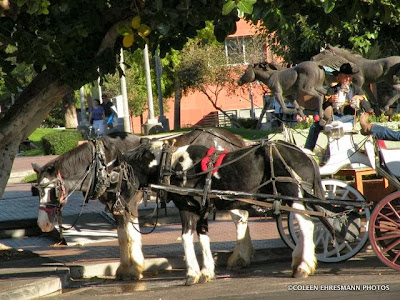I have been to Old Town Scottsdale before, but usually with other women. Our goal was shopping and eating. We also did an art gallery tour a couple of years ago. This visit was different. We visited some historic buildings and walked some of the back streets looking for caches. I would enjoy going back and spending more time with my camera.

When this structure was built in 1909, Scottsdale already had a wooden school built in 1896. Winfield Scott, the city's founder decided a brick structure "would better demonstrate both permanence and affluence of the community."


Through the years, the school served as few as 10 and as many as 100 students. The school was closed in 1954, but served as City Hall, County Court House, Justice of Peace Court and a Library. Today it is a museum.

Bronze statues of city founder, Winfield Scott, his wife Helen and their trusty mule, Maude. The statue marks the original site of the Scotts' homestead.

"Scottsdale began as a small farming community when Rhode Island banker Albert G. Utley subdivided 40 acres of virgin desert land into town lots in 1894 and named it to honor U. S. Army Chaplain Winfield Scott, whose untiring efforts brought most of the early settlers to the new community."

Decorated horse-drawn carriages for hire.
Their drivers enjoying the slow time...maybe?

The horses look just as bored.

Decorated street corners in the downtown area.

Concrete art work on another street corner.

I like the red cowboy boot.
Boxing glove lying nearby.

"The mission church was built with volunteer labor and donated materials in 1933 by the residents of the Mexican settlement. Jesus Corral, a leader in the Mexican community, took charge of the construction. The building's 14,000 adobe blocks, each weighing 50 pounds, were made right on site. Businesses and individuals donated sacks of cement and lumber. Barnebe Herrera, a tinsmith, made the stained glass windows. For many years this little church was the only Catholic church in Scottsdale."

This building next to the mission had interesting doors.

This ox-drawn cart is displayed in front of the Cavalliere's Blacksmith Shop. George Cavalliere brought his family to the area in 1910, wanting to put his shop along Main Street. The town fathers told him he would have to put it "out on the edge of town." The original building was tin, and replaced by this adobe structure in 1920.

The Cavallieres still own and operate the blacksmith shop, but in addition to the more conventional smithing functions, they now make ornamental wrought iron items as well.

An unused church tower

A stained class window of the vacant building
There were buildings and things I did not see but would like to sometime. I know there were caches we did NOT find, so we may be back...someday.
It makes me want to go to Scottsdale and look up these buildings. Do you know if the Mission Church is open to the public for church services?
ReplyDelete